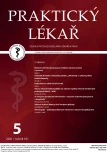Hyaluronane in the light of new
Authors:
Jiří Slíva
Authors‘ workplace:
Přednosta: MUDr. Jiří Slíva, Ph. D
; Ústav farmakologie 3. LF UK, Praha
Published in:
Prakt. Lék. 2021; 101(5): 258-260
Category:
Reviews
Overview
Hyaluronic acid (HA) has recently been mentioned very often all around us. Do we know other possible uses of HA except cosmetics? Hyaluronic acid (HA) is a natural polymer belonging to the group of hetero–polysaccharides known as glycosaminoglycans (GAG). These are naturally abundant, especially in the human vitreous, joints, umbilical cord, skin, and of course in connective tissue. We generally know that the human body contains hyaluronic acid. HA can be used in wound healing because HA can be said to de facto interfere with all key stages of the regeneration process, namely hemostasis, inflammatory response, proliferation and remodeling. Furthermore, HA is one of the most important components of the intercellular mass of connective tissue and is also significantly present in the synovial fluid. Due to its viscoelasticity, it absorbs mechanical shocks and significantly reduces friction between the joint heads. Therefore, it is offered as another possibility to use HA in a very common and painful disease – osteoarthritis.
Keywords:
osteoarthritis – Wound healing – hyaluronic acid – hemostasis – sinovial fluid – dosage forms
Sources
1. Aya KL, Stern R. Hyaluronan in wound healing: rediscovering a major player. Wound Repair Regen 2014; 22(5): 579–593.
2. Bowman S, Awad ME, Hamrick MW, et al. Recent advances in hyaluronic acid based therapy for osteoarthritis. Clin Transl Med 2018; 7(1): 6.
3. Brown TJ, Laurent UB, Fraser JR. Turnover of hyaluronan in synovial joints: elimination of labelled hyaluronan from the knee joint of the rabbit. Exp Physiol 1991; 76(1): 125–134.
4. Dierickx C, Larsson MK, Blomster S. Effectiveness and safety of acne scar treatment with nonanimal stabilized hyaluronic acid gel. Dermatol Surg 2018; 44(Suppl 1): S10–S18.
5. Fallacara A, Baldini E, Manfredini S, Vertuani S. Hyaluronic acid in the third millennium. Polymers (Basel). 2018; 10(7): 701.
6. Graça MFP, Miguel SP, Cabral CSD, Correia IJ. Hyaluronic acid-based wound dressings: A review. Carbohydr Polym. 2020; 241 : 116364.
7. Gupta RC, Lall R, Srivastava A, Sinha A. Hyaluronic acid: molecular mechanisms and therapeutic trajectory. Front Vet Sci 2019; 6 : 192.
8. Hašová M, Crhák T, Safránková B, et al. Hyaluronan minimizes effects of UV irradiation on human keratinocytes. Arch Dermatol Res 2011; 303(4): 277–284.
9. Kawada C, Kimura M, Masuda Y, Nomura Y. Oral administration of hyaluronan prevents skin dryness and epidermal thickening in ultraviolet irradiated hairless mice. J Photochem Photobiol B 2015; 153 : 215–221.
10. Maytin EV, Chung HH, Seetharaman VM. Hyaluronan participates in the epidermal response to disruption of the permeability barrier in vivo. Am J Pathol 2004; 165(4): 1331–1341.
11. Oe M, Sakai S, Yoshida H, et al. Oral hyaluronan relieves wrinkles: a double-blinded, placebo-controlled study over a 12-week period. Clin Cosmet Investig Dermatol 2017; 10 : 267–273.
12. Oliviero F, Ramonda R, Hoxha A, et al. Effect of an oral preparation containing hyaluronic acid, chondroitin sulfate, hydrolyzed collagen type II and hydrolyzed keratin on synovial fluid features and clinical indices in knee osteoarthritis. A pilot study. Reumatismo 2020; 72(3): 125–130.
13. Ricci M, Micheloni GM, Berti M, et al. Clinical comparison of oral administration and viscosupplementation of hyaluronic acid (HA) in early knee osteoarthritis. Musculoskelet Surg 2017; 101(1): 45–49.
14. Tamer TM. Hyaluronan and synovial joint: function, distribution and healing. Interdiscip Toxicol 2013; 6(3): 111–125.
15. Tavianatou AG, Caon I, Franchi M, et al. Hyaluronan: molecular size–dependent signaling and biological functions in inflammation and cancer. FEBS J 2019; 286(15): 2883–2908.
16. Webber J, Jenkins RH, Meran S, et al. Modulation of TGFbeta1 - dependent myofibroblast differentiation by hyaluronan. Am J Pathol 2009; 175(1): 148–160.
17. Wolny PM, Banerji S, Gounou C, et al. Analysis of CD44 - hyaluronan interactions in an artificial membrane system: insights into the distinct binding properties of high and low molecular weight hyaluronan. J Biol Chem 2010; 285(39): 30170–30180.
Labels
General practitioner for children and adolescents General practitioner for adultsArticle was published in
General Practitioner

2021 Issue 5
Most read in this issue
- Selected risk factors for stroke
- Bloodless clinical strategies for management of severe anaemia and hemorrhage
- Is the public sufficiently aware about the importance of pertussis vaccination in adulthood?
- Acromegaly – under-diagnosed disease with serious complications
